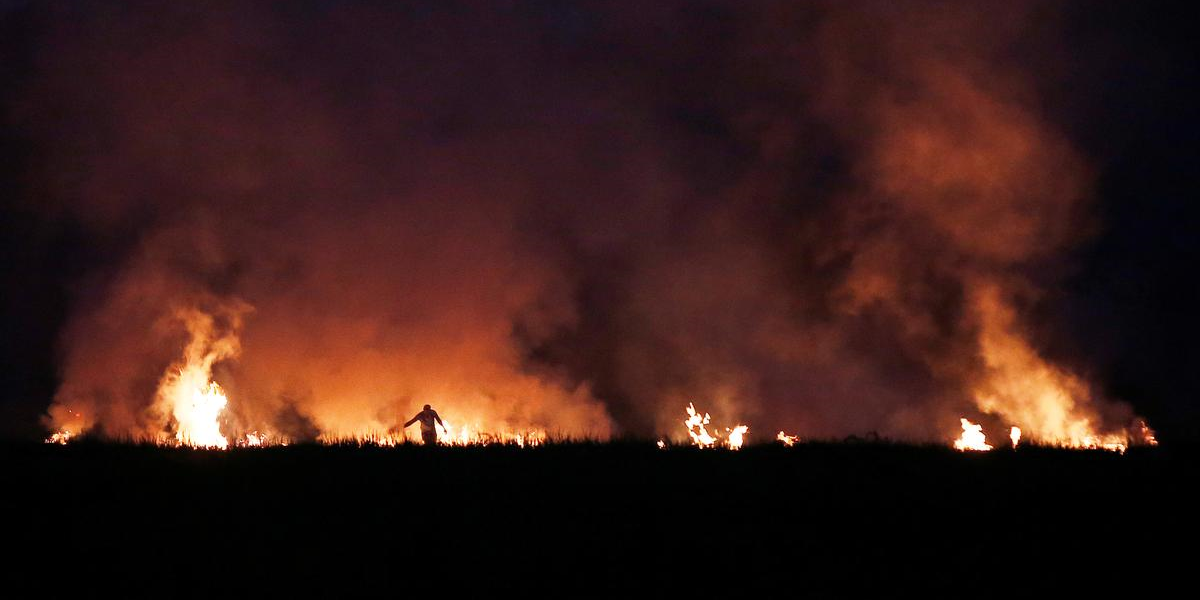Kochi: As Delhi and the surrounding National Capital Region gear up for stubble burning season – when farmers in the area and neighbouring states burn crop residue, which increases air pollution levels drastically during this time – central and state authorities are focusing on aspects including mandating the co-firing of biomass pellets as well as preventing stubble burning to limit air pollution.
At a meeting co-chaired by Union ministers for power, new and renewable energy; and environment, forest and climate change on October 3 in New Delhi, thermal power plants – especially those located in Punjab and Haryana – were directed to issue tenders to cover 5% co-firing of biomass pellets along with coal. Not complying will be met with strict action, and the Ministry of Power will also consider reducing coal supply to such plants, as per the proceedings of the meeting. Meanwhile, though Punjab is preparing an action plan to limit crop residue burning, resolution of the issue will take at least four to five years, said officials with the State Pollution Control Board.
Co-firing biomass pellets
Crop biomass which would otherwise be burnt in the open (e.g., crop residue such as straw leftover in fields after paddy harvests) can be ‘torrefied’ – subjected to intense heat to compress it into pellets that can be used as solid fuel. Research, as well as the use of such pellets in thermal power plants in developed countries, reveal that blending coal with such bio-pellets in thermal power plants can decrease carbon dioxide emissions significantly by decreasing the dependence of power plants on coal alone.
Such ‘biomass co-firing’ is a step that India has taken up in its efforts to decrease greenhouse gas emissions as per targets set under the Paris Agreement 2015 to mitigate climate change. One of the objectives of the National Mission on the use of Biomass in Thermal Power Plants (SAMARTH, conceived of in 2021) under the Ministry of Power is to increase co-firing biomass pellets from 5% to higher levels. In October last year, the Ministry of Power mandated that all coal-based thermal power plants (depending on their method of power generation) should co-fire at least 5% of biomass pellets along with coal. The co-firing policy will remain in use for 25 years, or till the end of the operation of the power plant.
However, even this current target is “far off”, the review meeting co-chaired by the two Union ministers in New Delhi found.
According to data presented by SAMARTH, there is an increase in power plants co-firing biomass pellets. While only 8 power plants co-fired biomass pellets in 2020-21, today, 39 power plants do so. This includes 10 thermal power plants in the NCR too. Yet, the amount of biomass co-fired is still trailing. As of March this year, only 23 thermal power plants had co-fired pellets totalling to 66,000 metric tonnes. As of date, the figure is 83,066 metric tonnes of biomass, co-fired in 39 thermal power plants across India. Power plants in the NCR region account for only 22,696 metric tonnes of this co-firing.
Also read: Government’s Irrational Policies on Pollution Are Affecting the Poor, Students
The meeting mandated that thermal power plants – especially those located in Punjab and Haryana – issue tenders to cover 5% co-firing of biomass pellets along with coal. Not complying will attract penalties, as per the Ministry of Power: it will consider reducing coal supply to such plants. All power plants including private power companies in the NCR have to also install biomass pellet manufacturing plants (torrefied/non-torrefied) on their premises. The Commission for Air Quality Management (CAQM) was also instructed to start considering penal provisions on plants that are not taking enough steps to co-fire sufficient quantities of biomass, the government press release said.

Chimneys of a coal-fired power plant are pictured in New Delhi. Photo: Reuters/Adnan Abidi
‘Resolution will take time’
Meanwhile, though Punjab is trying to address the crop residue burning problem, resolving it will take at least four-five years, said Krunesh Garg, member-secretary of the Punjab Pollution Control Board (PCB). Garg was speaking at a workshop organised in Chandigarh on October 3 by Climate Trends (a Delhi-based strategic communications initiative), Panjab University and Post Graduate Institute of Medical Education and Research (PGIMER) Chandigarh.
“It’s not that the problem is not being addressed. We are mapping it down to the block and village level, but it’ll take 4-5 years for proper problem resolution,” he said, per a press release. During this year’s Kharif season, the extent of paddy crop in Punjab alone amounts to 31.13 lakh hectares, said Garg in his presentation. This is an increase from the 29.61 lakh hectares of paddy sown in 2021 and will generate 19.76 million tonnes of paddy straw when compared to 18.74 tonnes last year.
Also read: IPCC Report: ‘Reality Check’ as Widespread Climate Changes Rapidly Intensify
Last year, the PCB formulated an action plan to control crop residue burning. This includes several in-situ management strategies such as promoting shorter-duration varieties of paddy and managing crop residue using machinery (such as Happy Seeder machines that cut paddy straw, lift it, and plant wheat seeds). The action plan is currently being updated based on revisions proposed by the CAQM, according to information shared by the PCB at the meeting.
Though the Board conducted trials of bio-decomposers, the results were not very promising, Garg said in the presentation. More trials are on the cards to determine the efficiency of bio-decomposers in reducing crop residue, he added.
Featured image: A farmer burns the stubble in a rice field in Karnal in Haryana, October 9, 2018. Photo: Reuters/Adnan Abidi
This article was first published on The Wire.

